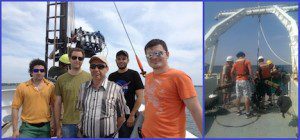
Shown here is the Coastal and Oceanic waters group, members of the Optical Remote Sensing Lab at The City College of New York.
Satellites provide useful information when properly calibrated. Learn how ocean research can play a key role in making Earth observation satellites more useful.
NASA research consists of using polarization properties developed as the light field propagates through the water body and uses this information to characterize and retrieve water constituents and inherent optical properties (also called IOPs) from polarimetric measurements. The basic idea is that as light propagates through the water, it experiences significant attenuation due to absorption by water and suspended/dissolved matter as well as scattering by water and suspended particulates.
These effects, both absorption and scattering, result in signal degradation of the radiance captured by sensors in instruments. The additional information obtained when using polarization properties of underwater light propagation can provide a better understanding of this propagation and methods for improving image quality and increase underwater visibility.
So how can this contribute to the goals and objectives pursued by the Ship-Aircraft Bio-Optical Research Campaign cruise? Well, the answer could be simple. The ocean is too big and in-situ measurements are too expensive to cover the entire water mass on Earth. Having this in mind, it is clear we need to adopt another cost-effective approach, and that is the reason why we use satellite observations to account for many changes that take place in the ocean and coastal waters.
Satellites provide useful information when properly calibrated, but sensors deteriorate over time and satellites go out of commission. However, polarization features are preserved even when the sensors may have experienced normal degradation, and such knowledge can contribute in the development of future technologies to be used in satellites when more accurate and reliable information is to be acquired. Some living and manmade objects in water have partially polarized surfaces whose properties can be advantageous in the context of target camouflage or, conversely, for easier detection. Such is the case for underwater polarimetric images taken to detect harmful algal blooms (red tides) or to assess the health of marine life and coral reefs, which are of significant scientific and technical interest.
Image courtesy of NASA/ Lynne Butler.

